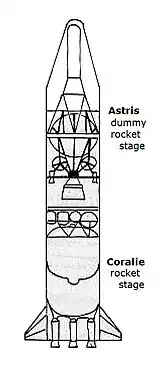 Cora rocket diagram | |
| Size | |
|---|---|
| Height | 11.5 m |
| Diameter | 2.01 m |
| Mass | 16.5 tonnes |
| Stages | 2 |
| Launch history | |
| Status | Retired |
| First stage – Coralie | |
| Height | 5.5 m |
| Diameter | 2.01 m |
| Gross mass | 9.85 tonnes |
| Powered by | 1 Coralie |
| Maximum thrust | 220 kN |
| Specific impulse | 280 s |
| Propellant | UDMH/N2O4 |
| Second stage – Astris | |
| Height | 132 inches (3.4 m) |
| Diameter | 79 feet (24 m) |
| Empty mass | 1,340 pounds (610 kg) |
| Gross mass | 7,430 pounds (3,370 kg) |
| Powered by | 1 Astris |
| Maximum thrust | 5,200 pounds-force (23 kN) |
| Specific impulse | 310 s |
| Burn time | 330 s |
| Propellant | Aerozine 50 / N2O4 |
Cora was a French experimental rocket.[1] It was the largest rocket ever launched in Western Europe.[2] It was primarily used for testing the second (Coralie) and third stages (Astris) of the multinational Europa Rocket,[3][4] which was developed and produced by the European Launcher Development Organisation, the predecessor to the present day European Space Agency.
For the Cora 1 only the French Coralie first stage was active. For the Cora 2 version the second German Astris stage was active. The Italian made Europa nose fairing was also tested.[3]
Configuration
The entire rocket had a length of 11.5 metres, a diameter of 2.01 m and a takeoff weight of 16.5 tonnes. Total thrust was 220.00 kN, with the rocket capable of reaching an apogee of 55 km.[3]
The Coralie first stage was 5.5 metres long and had a diameter of 2 metres; when fully fuelled, it weighed 9.85 tonnes; the propellant was a mixture of nitrogen tetroxide and unsymmetrical dimethylhydrazine (UDMH).[5] It was powered by a four-nozzle engine that produced 220 KN of thrust and had a specific impulse (in vacuum) of 280 seconds. A cylindrical black ring supporting four fins was attached to the rocket's base.[3]
The Astris second stage was 3.36 meters long with a diameter of 2 meters; when fully fuelled, it weighed 3.370 tonnes; the propellant was a mixture of nitrogen tetroxide and Aerozine-50. It was powered by an engine that produced 23.33 kN of thrust and had a specific impulse (in vacuum) of 310 seconds.[6]
 Cora 1 stages diagram
Cora 1 stages diagram Coralie 1st stage diagram
Coralie 1st stage diagram
Launch history
Six Cora launches were planned, the first four using the Cora 1 configuration and the last two using the Cora 2.[7] Only the three first launches took place, with the Cora 2 configuration never being tested:[7]
- On 27 November 1966, a first launch was conducted at the CIEES missile range and launch facility at Hammaguir, French Algeria. Guidance was lost at T+62s, with the rocket reaching an apogee of 10 km.[7] It was considered a half success.[1][3]
- On 18 December 1966, a second launch took place.[7] It reached an apogee of 55 km and was considered successful.[1][3]
- On 25 October 1967, Core was launched from Biscarrosse, Nouvelle-Aquitaine. Reaching an apogee of 10 km if failed due to a cabling issue.[1][3][7]
The following planned flights were cancelled and replaced by tests of the Europa rocket (Europa 1 F7, Europa 1 F6/1 and Europa 1 F6/2).[7]
See also
References
- 1 2 3 4 Gunter D, Krebs. "Cora". Gunter's Space Page. Retrieved 2023-07-30.
- ↑ Jacques Serra, Jean. "Cora experimental rockets". Rockets in Europe. Archived from the original on 14 November 2012. Retrieved 27 April 2018.
- 1 2 3 4 5 6 7 Wade, Mark. "Cora". Astronautix. Archived from the original on 28 December 2016. Retrieved 27 April 2018.
- ↑ Gunter D, Krebs. "Europa". Gunter's Space Page. Retrieved 2023-07-31.
- ↑ Wade, Mark (2016-12-28). "Europa-2". Astronautix. Archived from the original on 2016-12-28. Retrieved 2023-07-31.
- ↑ Wade, Mark (2016-12-28). "Astris". Astronautix. Archived from the original on 2016-12-28. Retrieved 2023-07-31.
- 1 2 3 4 5 6 Capdevila, Didier. "Tirs Cora". Capcom Espace. Retrieved 2023-08-27.